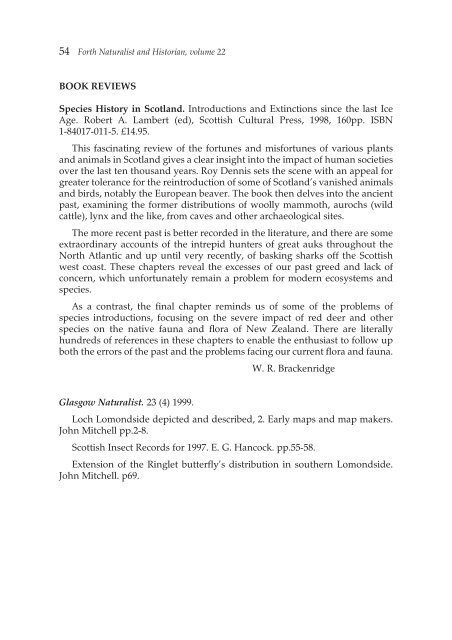the Forth Naturalist Historian - Forth Naturalist and Historian ...
the Forth Naturalist Historian - Forth Naturalist and Historian ...
the Forth Naturalist Historian - Forth Naturalist and Historian ...
You also want an ePaper? Increase the reach of your titles
YUMPU automatically turns print PDFs into web optimized ePapers that Google loves.
54 <strong>Forth</strong> <strong>Naturalist</strong> <strong>and</strong> <strong>Historian</strong>, volume 22<br />
BOOK REVIEWS<br />
Species History in Scotl<strong>and</strong>. Introductions <strong>and</strong> Extinctions since <strong>the</strong> last Ice<br />
Age. Robert A. Lambert (ed), Scottish Cultural Press, 1998, 160pp. ISBN<br />
1-84017-011-5. £14.95.<br />
This fascinating review of <strong>the</strong> fortunes <strong>and</strong> misfortunes of various plants<br />
<strong>and</strong> animals in Scotl<strong>and</strong> gives a clear insight into <strong>the</strong> impact of human societies<br />
over <strong>the</strong> last ten thous<strong>and</strong> years. Roy Dennis sets <strong>the</strong> scene with an appeal for<br />
greater tolerance for <strong>the</strong> reintroduction of some of Scotl<strong>and</strong>’s vanished animals<br />
<strong>and</strong> birds, notably <strong>the</strong> European beaver. The book <strong>the</strong>n delves into <strong>the</strong> ancient<br />
past, examining <strong>the</strong> former distributions of woolly mammoth, aurochs (wild<br />
cattle), lynx <strong>and</strong> <strong>the</strong> like, from caves <strong>and</strong> o<strong>the</strong>r archaeological sites.<br />
The more recent past is better recorded in <strong>the</strong> literature, <strong>and</strong> <strong>the</strong>re are some<br />
extraordinary accounts of <strong>the</strong> intrepid hunters of great auks throughout <strong>the</strong><br />
North Atlantic <strong>and</strong> up until very recently, of basking sharks off <strong>the</strong> Scottish<br />
west coast. These chapters reveal <strong>the</strong> excesses of our past greed <strong>and</strong> lack of<br />
concern, which unfortunately remain a problem for modern ecosystems <strong>and</strong><br />
species.<br />
As a contrast, <strong>the</strong> final chapter reminds us of some of <strong>the</strong> problems of<br />
species introductions, focusing on <strong>the</strong> severe impact of red deer <strong>and</strong> o<strong>the</strong>r<br />
species on <strong>the</strong> native fauna <strong>and</strong> flora of New Zeal<strong>and</strong>. There are literally<br />
hundreds of references in <strong>the</strong>se chapters to enable <strong>the</strong> enthusiast to follow up<br />
both <strong>the</strong> errors of <strong>the</strong> past <strong>and</strong> <strong>the</strong> problems facing our current flora <strong>and</strong> fauna.<br />
W. R. Brackenridge<br />
Glasgow <strong>Naturalist</strong>. 23 (4) 1999.<br />
Loch Lomondside depicted <strong>and</strong> described, 2. Early maps <strong>and</strong> map makers.<br />
John Mitchell pp.2-8.<br />
Scottish Insect Records for 1997. E. G. Hancock. pp.55-58.<br />
Extension of <strong>the</strong> Ringlet butterfly’s distribution in sou<strong>the</strong>rn Lomondside.<br />
John Mitchell. p69.



